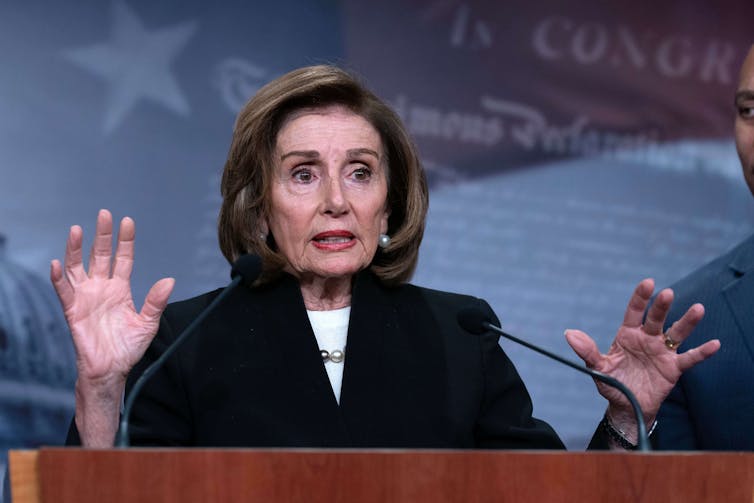Wen is a physician who teaches asylum medicine, trauma and collective healing. She is a public voices fellow with The OpEd Project in partnership with Massachusetts General Hospital.
By calling Haitian migrants with temporary protection status “illegal, ” vice presidential candidate J.D. Vance is spreading a more subtle and consequential lie than former President Donald Trump’s ridiculous accusations of migrants eating pets.
Our opaque migration pathways are ripe for misinformation that can fuel racist and xenophobic policies. In contrast, Minnesota Gov. Tim Walz, Vance’s opponent, has been a leader in progressive policies on migration such as advocacy for a pathway to citizenship for “Dreamers” and allowing all Minnesotans to obtain driver’s licenses regardless of documentation status.
Humane policies on migration — particularly for those fleeing forced displacement such as persecution, war and violence — are an acknowledgement that we are all humans bound by a desire to be safe and to protect our families, and that none of us are immune to political and environmental instability.
As of May, 120 million people had been forcibly displaced, according to the UN Refugee Agency. That’s equivalent to more than one-third of the U..S population or to the population of Japan. And it double from just a decade ago. This includes refugees — people granted this specific legal status before arriving in the host country based on five protected grounds of persecution (race, religion, nationality, political opinion and membership in a particular social group); asylum seekers, who are applying for this protection; and others who fit into a patchwork of programs that vary by country and geopolitics of the time. One example of this is temporary protection status many Haitian migrants have in the United States, which since its creation by Congress in 1990 allows people coming from certain countries deemed to have unsafe conditions such as war or natural disaster to temporarily live and work in the U.S.
I am an internal medicine physician; one of the most meaningful uses of my license is volunteering as a forensic evaluator for asylum applicants. I was trained to objectively document key parts of people’s reported history of traumas and signs and symptoms of the sequelae, psychological and/or physical, to assist the asylum officer or immigration judge to make their legal determination of asylum. Studies have shown that asylum seekers who had a forensic medical evaluation were twice as likely to be granted asylum than the national average (81 percent vs. 42 percent).
Seeking asylum, besides being an internationally recognized human right under international agreements of the United Nations 1951 Convention and 1967 Protocol, is codified in U.S. law. This fundamental human right should not be politicized further. U.S. Citizenship and Immigration Services, which manages our immigration and asylum processes, is vulnerable and constantly under the threat of attack and defunding for political reasons. As president, Trump slashed the numbers of refugees allowed by 80 percent, and through his closed-door policies crippled the funding mechanisms for USCIS. This, despite the fact that in the past 15 years, refugees and asylees contributed a net $123 billion profit to federal, state and local governments.
I initially became interested in asylum medicine because as a physician who cares for many migrants and displaced people, I witnessed the intense stress of uncertain migration status on my patients and the toll it takes on their health. One of my middle-aged patient’s chronic abdominal pain flares during his immigration decisions as it may be more bad news about separation from his wife and 10-year-old daughter. Another young woman with depression and insomnia has difficulty following up for her severe asthma as she tiptoes around her abusive partner because her and her children’s immigration status depends on him.
This “ violence of uncertainty ” is particularly harmful for people seeking asylum, refugees and other migrants who suffer from traumas of violence and persecution. Studies from the United Kingdom and the Netherlands have shown that longer wait times for asylum applicants are associated with worse physical and emotional health, independent of prior exposure to trauma and violence.
Conducting forensic evaluations for people applying for asylum and other protected statuses is one way to leverage my existing skills and privilege as a clinician to help other asylum applicants move through a byzantine, opaque, understaffed and underfunded system.
To be sure, the asylum process is far from perfect and focuses on an individual’s experience with being personally targeted by persecution on grounds that the U.S. sociopolitical system prioritizes. It does not address other key types of forced displacement such as the climate crisis — already pressing humanitarian disasters bound to become more catastrophic — or even being displaced by war and violence. Furthermore, we continue to detain and criminalize those who are deemed to have entered the U.S. illegally, even if they did so to seek asylum. That’s why we need updated, reformed, humane migration policies to reflect current drivers of migration.
Yet, I continue to participate in this flawed asylum system, much like I continue to go to work in a broken and inequitable health care system with the hopes of making it better. I keep returning because this work reminds me of why I became a physician in the first place: It’s a way to connect with common humanity. More than anything, I am struck by how similar stories are across the world, how fundamentally we are united by a desire for safety and belonging. In nearly every forensic interview, the client shares with me a deep desire to put their worst traumas in the past and plan for the future. They want to let go of the breath they’ve been holding for years, maybe decades — something they cannot do with uncertain status.
Healing from trauma takes place individually, interpersonally and societally. We can start where we are: Look around you, and in your own family history — when were your ancestors displaced and desperate for safety? How do you wish they were treated, and what skills do you have to help others now? Honor their memories by speaking out and voting for compassion and unity. Future generations are watching.




















